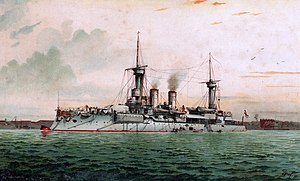
Back SMS Weißenburg Czech Weißenburg (Schiff) German SMS Weißenburg Spanish اساماس وایسنبورگ Persian SMS Weißenburg French SMS Weissenburg Italian SMS Weißenburg Polish SMS Weissenburg Portuguese Turgut Reis (zırhlı) Turkish SMS Weissenburg Vietnamese
 Lithograph of Weissenburg in 1902
| |
| History | |
|---|---|
| Name | Weissenburg |
| Namesake | Battle of Weissenburg |
| Builder | AG Vulcan Stettin |
| Laid down | May 1890 |
| Launched | 14 December 1891 |
| Commissioned | 14 October 1894 |
| Fate | Sold to the Ottoman Empire |
| Name | Turgut Reis |
| Namesake | Turgut Reis |
| Acquired | 12 September 1910 |
| Fate | Broken up, 1950–1957 |
| General characteristics | |
| Class and type | Brandenburg-class battleship |
| Displacement | |
| Length | 115.7 m (379 ft 7 in) loa |
| Beam | 19.5 m (64 ft) |
| Draft | 7.9 m (25 ft 11 in) |
| Installed power |
|
| Propulsion |
|
| Speed | 16.5 knots (30.6 km/h; 19.0 mph) |
| Range | 4,300 nautical miles (8,000 km; 4,900 mi) at 10 knots (19 km/h; 12 mph) |
| Complement |
|
| Armament |
|
| Armor | |
SMS Weissenburg[a] was one of the first ocean-going battleships of the Imperial German Navy. She was the third pre-dreadnought of the Brandenburg class, which also included her sister ships Brandenburg, Wörth, and Kurfürst Friedrich Wilhelm. Weissenburg was laid down in 1890 in the AG Vulcan dockyard in Stettin, launched in 1891, and completed in 1894. The Brandenburg-class battleships were unique for their era in that they carried six large-caliber guns in three twin turrets, as opposed to four guns in two turrets, as was the standard in other navies.
Weissenburg served with I Division during the first decade of her service with the fleet. This period was generally limited to training exercises and goodwill visits to foreign ports. These training maneuvers were nevertheless very important to developing German naval tactical doctrine in the two decades before World War I, especially under the direction of Alfred von Tirpitz. Weissenburg, along with her three sisters, saw only one major overseas deployment during this period, to China in 1900–1901, during the Boxer Uprising. The ship underwent a major modernization in 1904–1905.
In 1910, Weissenburg was sold to the Ottoman Empire and renamed Turgut Reis, after the famous 16th century Turkish admiral. The ship saw heavy service during the Balkan Wars, primarily providing artillery support to Ottoman ground forces. She also took part in two naval engagements with the Greek Navy—the Battle of Elli in December 1912, and the Battle of Lemnos the following month. Both battles were defeats for the Ottoman Navy. After the Ottoman Empire entered World War I, she supported the fortresses protecting the Dardanelles through mid-1915, and was decommissioned from August 1915 to the end of the war. She served as a training ship from 1924 to 1933, and a barracks ship until 1950, when she was broken up.
Cite error: There are <ref group=lower-alpha> tags or {{efn}} templates on this page, but the references will not show without a {{reflist|group=lower-alpha}} template or {{notelist}} template (see the help page).
© MMXXIII Rich X Search. We shall prevail. All rights reserved. Rich X Search